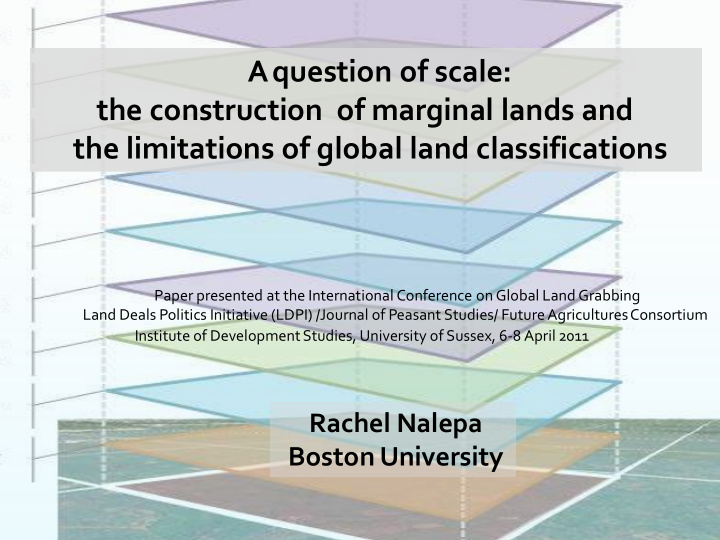



Aquestion of scale: the construction of marginal lands and the limitations of global land classifications Paper presented at the International Conference on Global Land Grabbing Land Deals Politics Initiative (LDPI) /Journal of Peasant Studies/ Future Agricultures Consortium Institute of Development Studies, University of Sussex, 6-8 April 2011 Rachel Nalepa Boston University
What is the purpose of global assessments? Global marginal land assessments are limited in distinguishing both suitable and available land for biofuels serves to obscure socio-ecological relationships for the sake of creating a new “resource imaginary”
Characterizing Marginal Land Step 1: Suitability Climate, soil profile, topography (e.g. agro-climatic factors) Step 2: Availability Land cover data (discount land that is being used, can’t be used) Discount: Forest Wetlands Urbanscapes Cultivated Land Protected Areas
Some suitability data: 5 arc minute= ~10 km at equator (agro-ecological data e.g. soil, terrain) Most suitability/availability 1 km 2 data: 30 arc second= ~1 km at equator (agro-ecological data & land cover data) 10 km
MODIS 250 m 1 km
Corn field Soy field Source: GDA Corp., 2011
Farmers make choices based on ‘an extensive margin of production’ determined by land quality AND socioeconomic factors: technological legal institutional macro-economic conditions credit accessibility land tenure policies etc. subsidies
Transforming landscapes into ‘mere space’ Sources: Mining Journal: ``African mining'', January, 1997; Bridge, 2001.
…land is “unusable”; it is "just marginal land." The district administrator responsible for the project went on to say that "the Region Total Area Area claimed suitable whole thing [sic] is nothing but positive” (Knaup 2008). (ha) for biofuels (ha) Tigray 5,007,864 6,500 Oromia 35,3000,681 17,234,523 BenishangulGumuz 4,928,946 3,128,251 SNNPR 11,234,319 49,025 < Gambella 2,580,261 2,829,999 Amhara 15,917,366 966,535 = ~20% nation’s total land area Source: CSA Ethiopia (2005), MoME (2007),(Aklilu 2008)
Recommend
More recommend